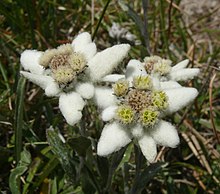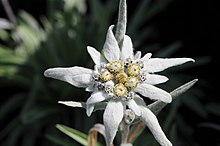Leontopodium nivale: Difference between revisions
| Line 46: | Line 46: | ||
==Symbolic uses== |
==Symbolic uses== |
||
* On the [[Austrian euro coins]], a picture of Edelweiss is used on the two-euro-cent coins. |
* On the [[Austrian euro coins]], a picture of Edelweiss is used on the two-euro-cent coins. |
||
* It is the symbol of the [http://btsbg.org/ Bulgarian Tourist Union] and the Bulgarian Mountain Control and Lifeguard Service (PKSS), |
* It is the symbol of the [http://btsbg.org/ Bulgarian Tourist Union] and the Bulgarian Mountain Control and Lifeguard Service (PKSS), http://pss.bg. |
||
* It is also the symbol of the [http://www.myswitzerland.com/en.cfm/home Swiss national tourism organisation] |
* It is also the symbol of the [http://www.myswitzerland.com/en.cfm/home Swiss national tourism organisation] |
||
* On the [[Romania]]n 50 [[Romanian Leu|Lei]] [[Banknotes of the Romanian leu#Banknotes of the fourth leu (RON)|banknote]]. |
* On the [[Romania]]n 50 [[Romanian Leu|Lei]] [[Banknotes of the Romanian leu#Banknotes of the fourth leu (RON)|banknote]]. |
||
Revision as of 16:14, 8 March 2012
| Edelweiss | |
|---|---|

| |
| Scientific classification | |
| Kingdom: | |
| (unranked): | |
| (unranked): | |
| (unranked): | |
| Order: | |
| Family: | |
| Tribe: | |
| Genus: | |
| Species: | L. alpinum
|
| Binomial name | |
| Leontopodium alpinum Cass., 1822
| |


Edelweiss /ˈeɪdəlvaɪs/ , Leontopodium alpinum, is a well-known mountain flower, belonging to the sunflower family.
Names
The common name comes from German edel, meaning "noble", and weiß (also spelled weiss) "white", thus signifying "noble whiteness".[2]
The scientific name Leontopodium is a Latin adaptation of Greek leontopódion (λεοντοπόδιον) "lion's paw", from léōn "lion" and pódion "foot" (diminutive of poús, podós "foot").[3]
The Romanian name, floarea reginei,[4] means "Queen's flower". Also, another common name is floare de colț which means "mountain flower".
The Persian name is gol-e-yax, which translates as "ice flower"
Description
Leaves and flowers are covered with white hairs and appear woolly (tomentose). Flowering stalks of Edelweiss can grow to a size of 3–20 cm (in cultivation, up to 40 cm). Each bloom consisting of five to six small yellow flower heads (5 mm) surrounded by bracts in star formation. The flowers are in bloom between July and September.
Range
The plant is unequally distributed and prefers rocky limestone places at 2000–2900 m altitude. It is not toxic, and has been used traditionally in folk medicine as a remedy against abdominal and respiratory diseases. The dense hair appears to be an adaptation to high altitudes, protecting the plant from cold, aridity and ultraviolet radiation.[5]
Since it usually grows in inaccessible places, it is associated in many countries of the alpine region with mountaineering.
Protection
Edelweiss is a protected plant in many countries, including Mongolia, Bulgaria, Croatia, Switzerland (since 1878), France, Norway, Iran, India (Zanskar region), Italy, Serbia, Malaysia (In Genting and Cameron Highlands), Indonesia (In Semeru Mountain), Germany, Spain (Ordesa National Park), Poland and Slovakia (Tatra National Park), Slovenia (in Gorizia and Gradisca since 1896, in Carniola since 1898), Austria (since 1886) and Romania (since 1933).
Cultivation
Leontopodium alpinum is grown in gardens for its interesting inflorescence and silver foliage.[6] The plants are short lived and can be grown from seed.[7]
Symbolic uses
- On the Austrian euro coins, a picture of Edelweiss is used on the two-euro-cent coins.
- It is the symbol of the Bulgarian Tourist Union and the Bulgarian Mountain Control and Lifeguard Service (PKSS), http://pss.bg.
- It is also the symbol of the Swiss national tourism organisation
- On the Romanian 50 Lei banknote.
- In Austria, Edelweiß is also a brand of beer named after the flower.
- Edelweiss is the unofficial national flower of Switzerland.
- The Edelweiss is used in the logotypes of several alpine clubs such as the Deutscher Alpenverein (German Alpine Club) or the Österreichischer Alpenverein (Austrian Alpine Club). The Edelweiss is also used in the logotype of the Union of International Mountain Leader Associations (UIMLA).
- Edelweiss Air, an international airline based in Switzerland, is named after the flower, which also appears in its logo.
- The song "Edelweiss", which is about the flower, is from Rodgers and Hammerstein's 1959 musical The Sound of Music, which takes place in Salzburg, Austria before World War II.
- "Bring me Edelweiss" is the best-known song of the music group Edelweiss.
- The Edelweiss was established 1907 as the sign of the Austrian-Hungarian alpine troops by Emperor Franz Joseph I. These original 3 Regiments wore their edelweiss on the collar of their uniform. During World War I (1915) the Edelweiss was granted to the German alpine troops, for their bravery. Today it is still the insignia of the Austrian, Polish, and German alpine troops.
- Edelweiss was a badge of Edelweiss Pirates (Edelweisspiraten)—the anti-Nazi youth groups in Third Reich. It was worn on the clothes (e.g. a blouse or a suit).
- The Edelweiss flower was the symbol of Wehrmacht and Waffen-SS Gebirgsjäger, or mountain rangers, worn as a metal pin on the left side of the mountain cap, on the band of the service dress cap, and as a patch on the right sleeve. It is still the symbol of the Mountain division in the German army today.
- The World War II Luftwaffe unit, Kampfgeschwader 51 (51st Bomber Wing) was known as the Edelweiss Wing.
- The rank insignia of Swiss generals use eight-pointed stars representing the flower. A Korpskommandant for example (equivalent to a Lieutenant General in other countries) wears three Edelweiss stars on his collar.
- Polish professional ice hockey team MMKS Podhale Nowy Targ use an Edelweiss as their emblem.
- The Edelweiss is represented as the favorite flower of Adolf Hitler, in the 1934 recording "Adolf Hitlers Lieblingsblume ist das schlichte Edelweiß"[8], sung by Harry Steier[9].
See also
References
- ^ Randall J. Bayer, Christopher F. Puttock, and Scot A. Kelchner (2000). "Phylogeny of South African Gnaphalieae (Asteraceae) based on two noncoding chloroplast sequences". American Journal of Botany. 87 (2): 259–272. doi:10.2307/2656914. JSTOR 2656914. PMID 10675314.
{{cite journal}}: CS1 maint: multiple names: authors list (link) - ^ William Shepard Walsh (1909). Handy-book of literary curiosities. J.B. Lippincott Co. pp. 268–. Retrieved 19 August 2010.
- ^ λέων, πόδιον, πούς. Liddell, Henry George; Scott, Robert; A Greek–English Lexicon at the Perseus Project
- ^ Taner Murat. Dicționar român — tătar crimean, Sózlík kazakşa — kîrîm tatarşa|ur l=http://books.google.com/books?id=e6vnF1A0dvkC&pg=PA136. Taner Murat. pp. 136–. ISBN 9789736922657.
{{cite book}}:|access-date=requires|url=(help) - ^ Vigneron, Jean Pol (January 2005). "Optical structure and function of the white filamentary hair covering the edelweiss bracts". Physical Review E. 71. American Physical Society. arXiv:0710.2695.
{{cite journal}}: Unknown parameter|coauthors=ignored (|author=suggested) (help) - ^ Mineo, Baldassare (1999). Rock garden plants: a color encyclopedia. Portland, Or.: Timber Press. p. 150. ISBN 0-88192-432-6.
{{cite book}}: Cite has empty unknown parameter:|coauthors=(help) - ^ McVicar, Jekka. Seeds: The Ultimate Guide to Growing Successfully from Seed. The Lyons Press. p. 22. ISBN 1-58574-874-9.
{{cite book}}: Cite has empty unknown parameter:|coauthors=(help) - ^ http://www.youtube.com/watch?v=dRVL63lh5QM
- ^ http://forum.axishistory.com/viewtopic.php?p=1180704#p1180704
